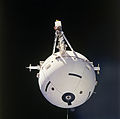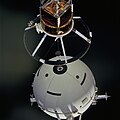STS-46
Appearance
 | |
| Names | Space Transportation System-46 |
|---|---|
| Mission type | EURECA satellite deployment TSS-1 operation Technology research |
| Operator | NASA |
| COSPAR ID | 1992-049A |
| SATCAT no. | 22064 |
| Mission duration | 7 days, 23 hours, 15 minutes, 2 seconds |
| Distance travelled | 5,344,643 km (3,321,007 mi) |
| Orbits completed | 127 |
| Spacecraft properties | |
| Spacecraft | Space Shuttle Atlantis |
| Launch mass | 116,134 kg (256,032 lb) |
| Landing mass | 94,676 kg (208,725 lb) |
| Payload mass | 12,164 kg (26,817 lb) |
| Crew | |
| Crew size | 7 |
| Members | |
| Start of mission | |
| Launch date | July 31, 1992, 13:56:48 UTC (9:56:48 am EDT) |
| Launch site | Kennedy, LC-39B |
| Contractor | Rockwell International |
| End of mission | |
| Landing date | August 8, 1992, 13:11:50 UTC (9:11:50 am EDT) |
| Landing site | Kennedy, SLF Runway 33 |
| Orbital parameters | |
| Reference system | Geocentric orbit |
| Regime | Low Earth orbit |
| Perigee altitude | 425 km (264 mi) |
| Apogee altitude | 437 km (272 mi) |
| Inclination | 28.46° |
| Period | 93.2 minutes |
| Instruments | |
| |
 STS-46 mission patch  Standing: Ivins, Nicollier, Hoffman, Chang-Díaz and Malerba Seated: Allen and Shriver | |
STS-46 was a NASA Space Shuttle mission using Atlantis and was launched on July 31, 1992, and landed on August 8, 1992.
Crew
[edit]| Position | Astronaut | |
|---|---|---|
| Commander | Third and last spaceflight | |
| Pilot | First spaceflight | |
| Mission Specialist 1 | First spaceflight | |
| Mission Specialist 2 Flight Engineer |
Second spaceflight | |
| Mission Specialist 3 | Third spaceflight | |
| Mission Specialist 4 | Third spaceflight | |
| Payload Specialist 1 | Only spaceflight | |
| Robert L. Gibson had originally been selected to command STS-46, however, after he was involved in an air-race collision, he was suspended from training for this mission.[1] Gibson would fly again on STS-47. | ||
| Position | Astronaut | |
|---|---|---|
| Payload Specialist 1 | ||
Crew seat assignments
[edit]| Seat[2] | Launch | Landing |  Seats 1–4 are on the flight deck. Seats 5–7 are on the mid-deck. |
|---|---|---|---|
| 1 | Shriver | ||
| 2 | Allen | ||
| 3 | Nicollier | Hoffman | |
| 4 | Ivins | ||
| 5 | Hoffman | Nicollier | |
| 6 | Chang-Díaz | ||
| 7 | Malerba | ||
Mission highlights
[edit]This section is empty. You can help by adding to it. (October 2024) |
Gallery
[edit]-
EURECA after deployment
-
TSS-1 satellite
-
TSS-1 tether close-up deployment
-
TSS-1 fully extended deployment
See also
[edit]- List of human spaceflights
- List of Space Shuttle missions
- Outline of space science
- Space Shuttle
- STS-75, a space shuttle mission with objectives similar to those of STS-46
References
[edit]![]() This article incorporates public domain material from websites or documents of the National Aeronautics and Space Administration.
This article incorporates public domain material from websites or documents of the National Aeronautics and Space Administration.
- ^ Harwood, William (July 9, 1990). "Two shuttle commanders disciplined, grounded". UPI Archive. Retrieved January 18, 2022.
Gibson also was barred from T-38 jet trainer flights for one year while Walker was grounded for 60 days. Neither pilot will be eligible for reassignment to a shuttle mission until they are back on T-38 flight status.
- ^ "STS-46". Spacefacts. Retrieved March 4, 2014.
Further reading
[edit]- NASA mission summary Archived May 27, 2010, at the Wayback Machine









